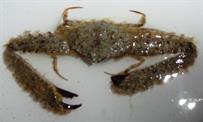



Platylambrus granulata
Notes
VERY similar to the Sawtooth Elbow Crab (Parthenope serratus). This male specimen was distinguished upon close examination using the differentiators in the paper by Gore (1977), (Studies on Decapod Crustacea from the Indian River Region of Florida, VI. The Identity of Parthenope (Platylambrus) Serrata (H. Milne Edwards 1834) and Parthenope (Platylambrus) Granulata (Kingsley 1879))
Size
Capapace width to 2.5cm
Description:
Extremely long chelipeds (claw arms) x3 as long as capapace width. Greyish (though may be covered in substrate material and epibiota e.g. algae. Carapace with numerous tubercles (smallvbumps) and a scattering of black spots. Claws dark and bases may be purplish. Underside pale. Chelipeds with long and broad anteriorally curved spines. These are only on the outer edge of the propodus (last segment) but on both sides of the merus. Smaller curved spines around edge of carapace, especially on the anterio-lateral margin.
Ecology
Found on sandy or muddy bottoms, including in seagrass beds. Depths from 2-60m (6-180ft). A general carnivore eating e.g. worms and small snails and bivalve molluscs.
Life Cycle
Reproduce sexually with separate sexes which remain constant throughout their lives.. The females can be distinguished from the males by having a broader abdomen ( see "sexing true crabs"). This is an adaptation to allow them to carry the eggs under the abdomen until they hatch into the various stages of pelagic larvae.
VERY similar to the Sawtooth Elbow Crab (Parthenope serratus). This male specimen was distinguished upon close examination using the differentiators in the paper by Gore (1977), (Studies on Decapod Crustacea from the Indian River Region of Florida, VI. The Identity of Parthenope (Platylambrus) Serrata (H. Milne Edwards 1834) and Parthenope (Platylambrus) Granulata (Kingsley 1879))
Size
Capapace width to 2.5cm
Description:
Extremely long chelipeds (claw arms) x3 as long as capapace width. Greyish (though may be covered in substrate material and epibiota e.g. algae. Carapace with numerous tubercles (smallvbumps) and a scattering of black spots. Claws dark and bases may be purplish. Underside pale. Chelipeds with long and broad anteriorally curved spines. These are only on the outer edge of the propodus (last segment) but on both sides of the merus. Smaller curved spines around edge of carapace, especially on the anterio-lateral margin.
Ecology
Found on sandy or muddy bottoms, including in seagrass beds. Depths from 2-60m (6-180ft). A general carnivore eating e.g. worms and small snails and bivalve molluscs.
Life Cycle
Reproduce sexually with separate sexes which remain constant throughout their lives.. The females can be distinguished from the males by having a broader abdomen ( see "sexing true crabs"). This is an adaptation to allow them to carry the eggs under the abdomen until they hatch into the various stages of pelagic larvae.

| Ecological Descriptors | ||||
| Habitat | Size (cm) | Diet | Behaviour | Sex |
| S, M | 2.5 (carapace width)) | Mol, Wor | I | F |

Bladetooth Elbow Crab


515

Bladetooth Elbow Crab





516

